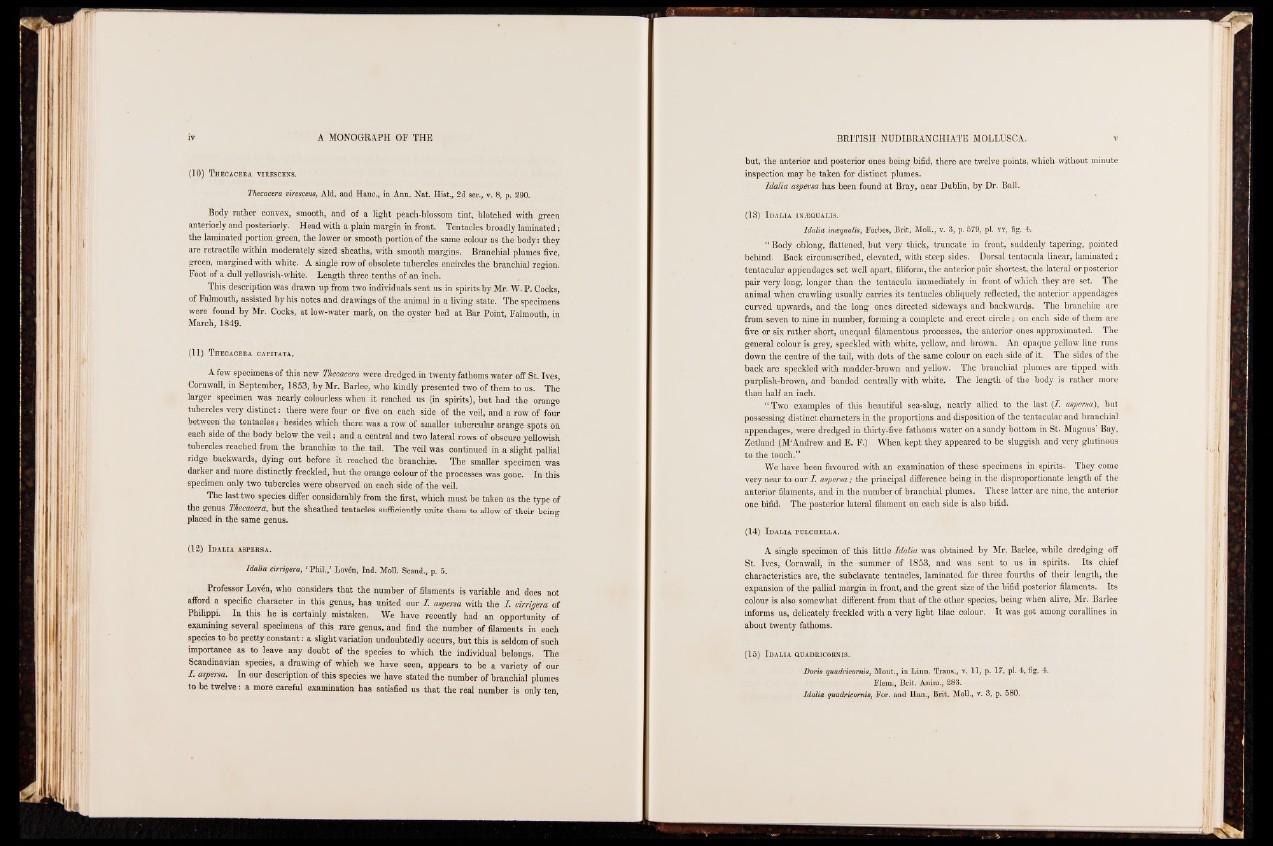
(10) Thecacera virescens.
Thecacera virescens, Aid. and Hanc., in Ann. Nat. Hist., 2d ser., v. 8, p. 290.
Body rather convex, smooth, and of a light peach-blossom tint, blotched with green
anteriorly and posteriorly. Head with a plain margin in front. Tentacles broadly laminated;
the laminated portion green, the lower or smooth portion of the same colour as the body: they
are retractile within moderately sized sheaths, with smooth margins. Branchial plumes five,
green, margined with white. A single row of obsolete tubercles encircles the branchial region.
Foot of a dull yellowish-white. Length three tenths of an inch.
This description was drawn up from two individuals sent us in spirits by Mr. W. P. Cocks,
of Falmouth, assisted by his notes and drawings of the animal in a living state. The specimens
were found by Mr. Cocks, at low-water mark, on the oyster bed at Bar Point, Falmouth, in
March, 1849.
(11) Thecacera capitata.
A few specimens of this new Thecacera were dredged in twenty fathoms water off St. Ives,
Cornwall, in September, 1853, by Mr. Barlee, who kindly presented two of them to us. The
larger specimen was nearly colourless when it reached us (in spirits), but had the orange
tubercles very distinct: there were four or five on each side of the veil, and a row of four
between the tentacles; besides which there was a row of smaller tubercular orange spots on
each side of the body below the veil; and a central and two lateral rows of obscure yellowish
tubercles reached from the branchiae to the.tail. The veil was continued in a slight pallial
ridge backwards, dying out before it reached the branchiae The smaller specimen was
darker and more distinctly freckled, but the orange colour of the processes was gone. In this
specimen only two tubercles were observed on each side of the veil.
The last two species differ considerably from the first, which must be taken as the type of
the genus Thecacera, but the sheathed tentacles sufficiently unite them to allow of their being
placed in the same genus.
(12) Id alia aspersa.
Idalia cirrigera, ‘ Phil./ Loven, Ind. Moll. Scand., p. 5.
Professor Loven, who considers that the number of filaments is variable and does not
afford a specific character in this genus, has united our I . aspersa with the 1. cirrigera of
Philippi. In this he is certainly mistaken. We have recently had an opportunity of
examining several specimens of this rare genus, and find the number of filaments in each
species to be pretty constant: a slight variation undoubtedly occurs, but this is seldom of such
importance as to leave any doubt of the species to which the individual belongs. The
Scandinavian species, a drawing of which we have seen, appears to be a variety of our
I . aspersa. In our description of this species we have stated the number of branchial plumes
to be twelve: a more careful examination has satisfied us that the real number is only ten,
but, the anterior and posterior ones being bifid, there are twelve points, which without minute
inspection may be taken for distinct plumes.
Idalia aspersa has been found at Bray, near Dublin, by Dr. Ball.
(13) Idalia injsqualis.
Idalia incequalis, Forbes, Brit. Moll., v. 3, p. 579, pi. yy, fig. 4.
“ Body oblong, flattened, but very thick, truncate in front, suddenly tapering, pointed
behind. Back circumscribed, elevated, with steep sides. Dorsal tentacula linear, laminated;
tentacular appendages set well apart, filiform, the anterior pair shortest, the lateral or posterior
pair very long, longer than the tentacula immediately in front of which they are set. The
animal when crawling usually carries its tentacles obliquely reflected, the anterior appendages
curved upwards, and the long ones directed sideways and backwards. The branchiae are
from seven to nine in number, forming a complete and erect circle; on each side of them are
five or six rather short, unequal filamentous processes, the anterior ones approximated. The
general colour is grey, speckled with white, yellow, and brown. An opaque yellow line runs
down the centre of the tail, with dots of the same colour on each side of it. The sides of the
back are speckled with madder-brown and yellow. The branchial plumes are tipped with
purplish-brown, and banded centrally with white. The length of the body is rather more
than half an inch.
“ Two examples of this beautiful sea-slug, nearly allied to the last (/. aspersa), but
possessing distinct characters in the proportions and disposition of the tentacular and branchial
appendages, were dredged in thirty-five fathoms water on a sandy bottom in St. Magnus’ Bay,
Zetland (M*Andrew and E. F.) When kept they appeared to be sluggish and very glutinous
to the touch.”
We have been favoured with an examination of these specimens in spirits. They come
very near to our I . aspersa; the principal difference being in the disproportionate length of the
anterior filaments, and in the number of branchial plumes. These latter are nine, the anterior
one bifid. The posterior lateral filament on each side is also bifid.
(14) Idalia pulchella.
A single specimen of this little Idalia was obtained by Mr. Barlee, while dredging off
St. Ives, Cornwall, in the summer of 1853, and was sent to us in spirits. Its chief
characteristics are, the subclavate tentacles, laminated for three fourths of their length, the
expansion of the pallial margin in front, and the great size of the bifid posterior filaments. Its
colour is also somewhat different from that of the other species, being when alive, Mr. Barlee
informs us, delicately freckled with a very light lilac colour. It was got among corallines in
about twenty fathoms.
(15) Idalia quadricornis.
Doris quadricornis, Mont., in Linn. Trans., v. 11, p. 17, pi. 4, fig. 4.
Flem., Brit. Anim., 283.
Idalia quadricornis, For. and Han., Brit. Moll., v. 3, p. 580.